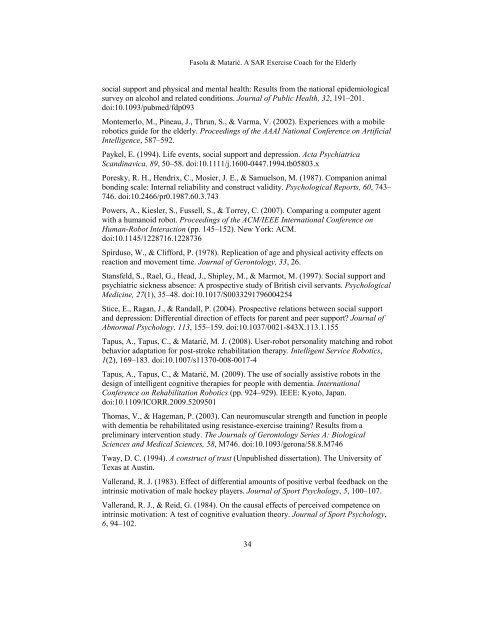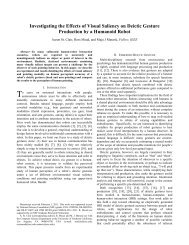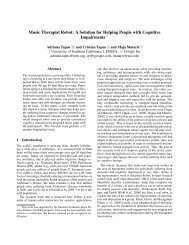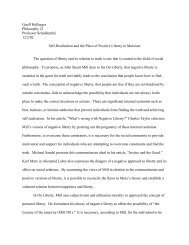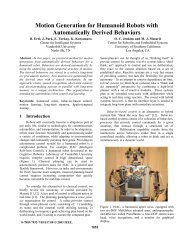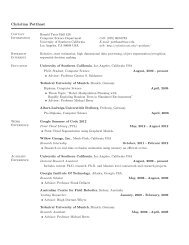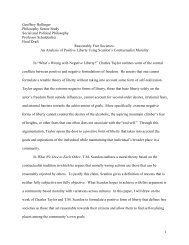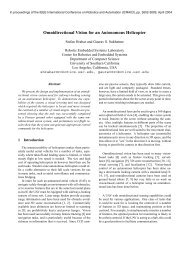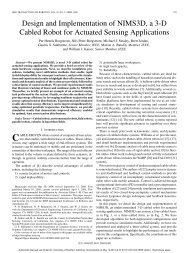A Socially Assistive Robot Exercise Coach for the Elderly
A Socially Assistive Robot Exercise Coach for the Elderly
A Socially Assistive Robot Exercise Coach for the Elderly
You also want an ePaper? Increase the reach of your titles
YUMPU automatically turns print PDFs into web optimized ePapers that Google loves.
Fasola & Matarić. A SAR <strong>Exercise</strong> <strong>Coach</strong> <strong>for</strong> <strong>the</strong> <strong>Elderly</strong>social support and physical and mental health: Results from <strong>the</strong> national epidemiologicalsurvey on alcohol and related conditions. Journal of Public Health, 32, 191–201.doi:10.1093/pubmed/fdp093Montemerlo, M., Pineau, J., Thrun, S., & Varma, V. (2002). Experiences with a mobilerobotics guide <strong>for</strong> <strong>the</strong> elderly. Proceedings of <strong>the</strong> AAAI National Conference on ArtificialIntelligence, 587–592.Paykel, E. (1994). Life events, social support and depression. Acta PsychiatricaScandinavica, 89, 50–58. doi:10.1111/j.1600-0447.1994.tb05803.xPoresky, R. H., Hendrix, C., Mosier, J. E., & Samuelson, M. (1987). Companion animalbonding scale: Internal reliability and construct validity. Psychological Reports, 60, 743–746. doi:10.2466/pr0.1987.60.3.743Powers, A., Kiesler, S., Fussell, S., & Torrey, C. (2007). Comparing a computer agentwith a humanoid robot. Proceedings of <strong>the</strong> ACM/IEEE International Conference onHuman-<strong>Robot</strong> Interaction (pp. 145–152). New York: ACM.doi:10.1145/1228716.1228736Spirduso, W., & Clif<strong>for</strong>d, P. (1978). Replication of age and physical activity effects onreaction and movement time. Journal of Gerontology, 33, 26.Stansfeld, S., Rael, G., Head, J., Shipley, M., & Marmot, M. (1997). Social support andpsychiatric sickness absence: A prospective study of British civil servants. PsychologicalMedicine, 27(1), 35–48. doi:10.1017/S0033291796004254Stice, E., Ragan, J., & Randall, P. (2004). Prospective relations between social supportand depression: Differential direction of effects <strong>for</strong> parent and peer support? Journal ofAbnormal Psychology, 113, 155–159. doi:10.1037/0021-843X.113.1.155Tapus, A., Tapus, C., & Matarić, M. J. (2008). User-robot personality matching and robotbehavior adaptation <strong>for</strong> post-stroke rehabilitation <strong>the</strong>rapy. Intelligent Service <strong>Robot</strong>ics,1(2), 169–183. doi:10.1007/s11370-008-0017-4Tapus, A., Tapus, C., & Matarić, M. (2009). The use of socially assistive robots in <strong>the</strong>design of intelligent cognitive <strong>the</strong>rapies <strong>for</strong> people with dementia. InternationalConference on Rehabilitation <strong>Robot</strong>ics (pp. 924–929). IEEE: Kyoto, Japan.doi:10.1109/ICORR.2009.5209501Thomas, V., & Hageman, P. (2003). Can neuromuscular strength and function in peoplewith dementia be rehabilitated using resistance-exercise training? Results from apreliminary intervention study. The Journals of Gerontology Series A: BiologicalSciences and Medical Sciences, 58, M746. doi:10.1093/gerona/58.8.M746Tway, D. C. (1994). A construct of trust (Unpublished dissertation). The University ofTexas at Austin.Vallerand, R. J. (1983). Effect of differential amounts of positive verbal feedback on <strong>the</strong>intrinsic motivation of male hockey players. Journal of Sport Psychology, 5, 100–107.Vallerand, R. J., & Reid, G. (1984). On <strong>the</strong> causal effects of perceived competence onintrinsic motivation: A test of cognitive evaluation <strong>the</strong>ory. Journal of Sport Psychology,6, 94–102.34


